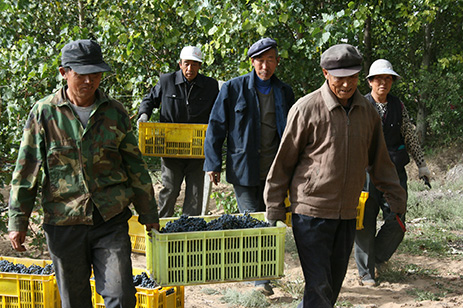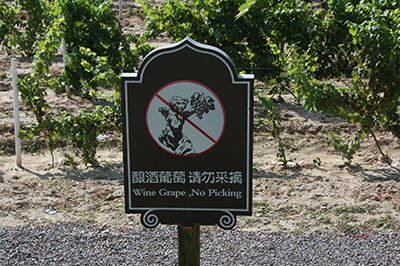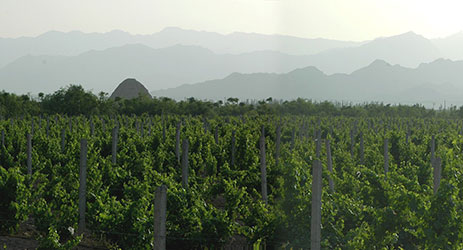Jefford on Monday
The pace is fierce in Ningxia. This is a wine-growing region where ‘old vines’ means those that have seen out ten summers. Of the 110 winery leases that have been granted so far, 50 wineries are under construction (or is it 77? – figures here depend on who you talk to) and around 10 are in production – yet the regional powers are already discussing a classification system.

Ningxia’s 34,000 ha is slated to double in the next decade, and the region is aiming to be the biggest organic wine-production area in the world. Its Inner Mongolian neighbour, Wuhai, has the same ambition.
‘The conditions are so good,’ one local producer was quoted (by the China Daily) as saying, ‘that grapes can be anything they aspire to be.’ Another producer, busy building not just one but a series of ‘Italian, French and South-African style chateaus’, confided to the paper that ‘I already sell puffed food to every corner of the world. There is no reason why I cannot sell Ningxia wine all over the world.’ Yet when I asked one of China’s wisest consulting winemakers, Li Demei, just which wines Ningxia was going to prove best at producing, he was emphatically non-committal. ‘It’s too early to say – about almost everything. You wouldn’t judge an adult on the two-year-old infant he once was. That’s the stage we’re at.’ And he’s right.
The challenges are enormous: Ningxia and Wuhai are like no other wine-regions I have ever visited, though Argentina’s Mendoza is a distant cousin. Easily the biggest of these challenges lie in the vineyard; many looked frankly dilapidated, despite their youth.
The vines are often planted in deep sand, with little organic matter, though Ningxia has other soil types, too; soil pHs can be very high (over 9 in some places); irrigation is primitive. ‘Our vineyard,’ – Brett Richardson of Pernod Ricard’s Helan Mountain provides a typical narrative – ‘was made out of Gobi desert sand hills. They were flattened out, irrigated and planted.’ Once every decade or so in this high-altitude (around 1,200m), rigorously continental climate, winter temperatures will drop down to -25°C or more, so every vine needs to be laid down and buried each winter to ensure winter survival. This, though, limits their life to little more than 15 years; after that, the trunks break.
Most vineyards are field blends of Cabernet Sauvignon with other related varieties including the long-domesticated Cabernet Gernischt (Carmenère, according to José Vouillamoz’s DNA analyses), and fan leaf and red blotch viruses are rife, particularly in the latter variety. The end result is often a muddle of dead or missing vines with diseased ones, struggling ones, injured ones and prolifically leafy ones, with bunches all over the plants. The local ‘dragon’s head’ pruning system is a vague sprawl. ‘Seasonal change,’ as Richardson puts it, ‘is cliff-faced’, with summer collapsing into winter as the first frosts arrive in mid-October, at which point the Cabernet family may or may not be quite ripe.

Almost mysteriously, though, something or other works well here. The texture and depth of the best red wines (few as yet) is impressive, with satisfying tannic profiles. The flavours are rarely overdrawn, hot or exaggerated; alcohol integration is good; they take well to discreet oaking; and when you do find genuine richness and wealth of flavour, it’s often allied to freshness. (With effort, in other words, the battle with the greenness which plagues many Chinese reds is winnable here.)
The challenge of the region’s severe continentality shouldn’t be underestimated, but many feel that conditions here are far more propitious than they are in the summer-rain-harried east of China. Growing-season weather is reliable: ‘good enough to achieve perfect ripeness in the majority of varieties during normal seasons,’ assessed Argentinian viticulturalist Edy del Popolo of Dominio del Plata after a recent visit, with little or no fungal disease pressure. Del Popolo traveled more widely in the region than my colleague Anthony Rose and I had the chance to do, and suggest that different sites in Ningxia might have degree-day totals which vary from 1400 to 2000 or so: surprisingly diverse, if so.
Once the enormous vineyard challenges are overcome, and a couple of decades of experiment has got underway to match site and variety, then the Gobi desert vineyards of Ningxia and Wuhai may surprise us all.
Front Runners in Ningxia and Wuhai
Château Bacchus A promising 2012 Syrah barrel sample suggests that the Cabernet family may not be the only choice for Ningxia.
Hansen The Wahai pioneer and Inner Mongolian leader has a good reputation in China for its entry-level wines, while 2012 barrel samples of top Cabernet cuvees from local Inner Mongolian vineyards show outstanding ripeness profiles. Winemaker Bruno Paumard (originally from the Loire) is in love with Cabernet Gernischt; in his hands it can taste like a decent Chinon.
Helan Qingxue The triumph of the indubitably classy 2009 Jia Beilan Grande Réserve at the 2011 Decanter World Wine Awards put Ningxia on the map and convinced the local government to invest heavily in wine production; the super-selection ‘Baby Feet’ version of this wine is now one of China’s most sought-after bottles. A vertical tasting with winemaker Zhang Jing of 2005 to barrel samples of the 2012 shows the speed of progress at this winery, advised by Li Demei – and the value of its stringent vineyard selections.
Lanny Château Local government-owned estate producing fair Cabernet blends.
Leirenshou A name to watch at present, especially now that Li Demei is lending a hand; the range includes an attractive Pinot with cherrystone poise and a promising prestige Cabernet/Merlot blend called Yijing.
Silver Heights Talented Emma Gao is refining her style, and these remain some of the most exuberant and richly styled of Ningxia’s wines: a regional reference.
Yuan Shi The beautiful winery, with its finely crafted stonework and indigenous architectural motifs, comes as a great relief after the Disney-esque excess of some of its rivals. The 2012 Chardonnay was the best white I tried in Ningxia, and barrel samples of the 2012 Cabernet were delicious; French consultant Patrick Soye is now based here.

Columnist Introduction
Andrew Jefford is a columnist for both Decanter magazine and www.decanter.com, Jefford has been writing and broadcasting about wine (as well as food, whisky, travel and perfume) since the 1980s, winning many awards – the latest for his work as a columnist. After 15 months as a senior research fellow at Adelaide University between 2009 and 2010, Andrew is currently writing a book on Australia’s wine landscape and terroirs. He lives in the Languedoc, on the frontier between the Grès de Montpellier and Pic St Loup zones.
Click here to read all articles by Andrew Jefford>>
- Follow us on Weibo@Decanter醇鉴 and Facebook
and Facebook for the latest news and updates -
for the latest news and updates -
All rights reserved by Future plc. No part of this publication may be reproduced, distributed or transmitted in any form or by any means without the prior written permission of Decanter.
Only Official Media Partners (see About us) of DecanterChina.com may republish part of the content from the site without prior permission under strict Terms & Conditions. Contact china@decanter.com to learn about how to become an Official Media Partner of DecanterChina.com.


Comments
Submit